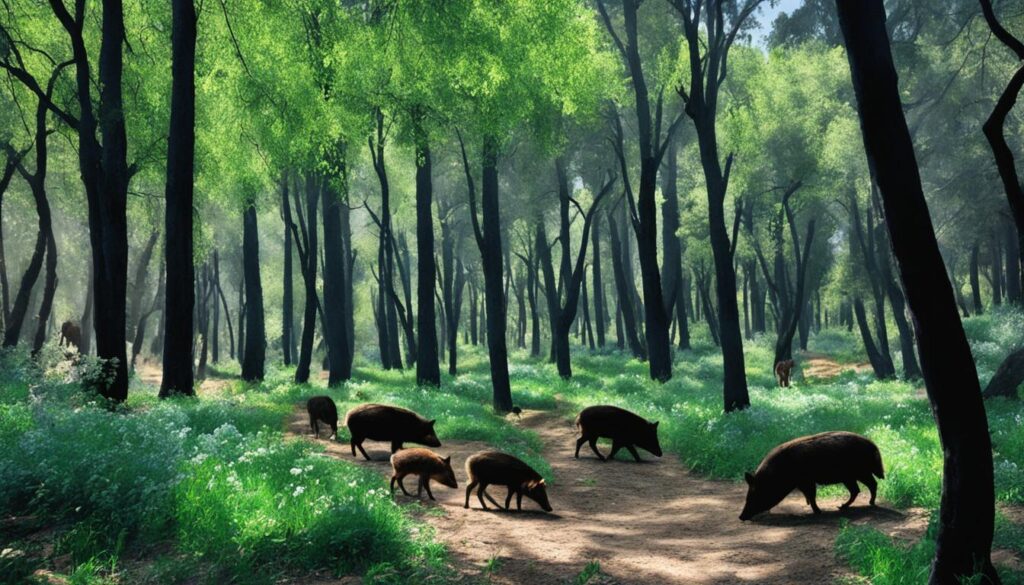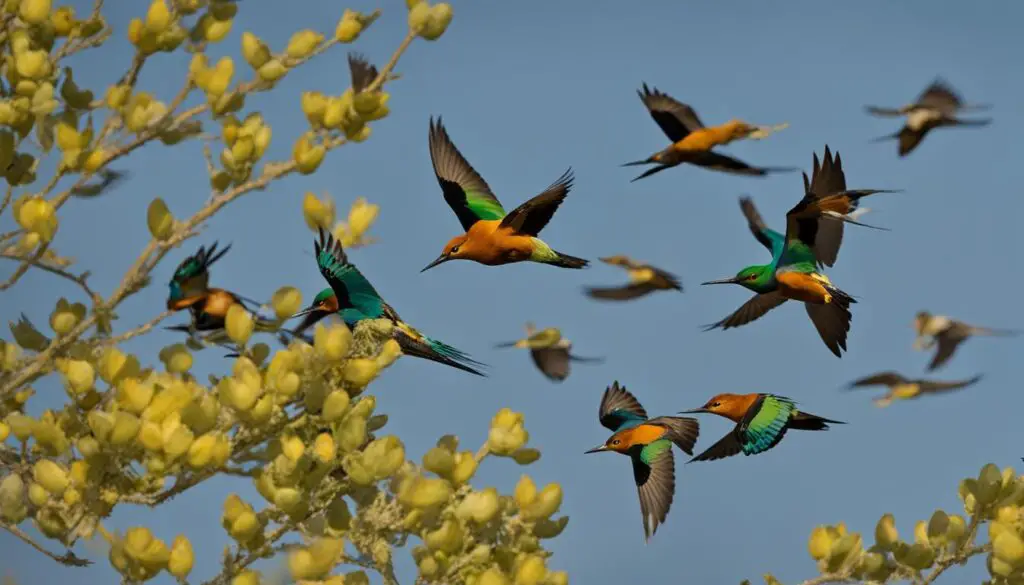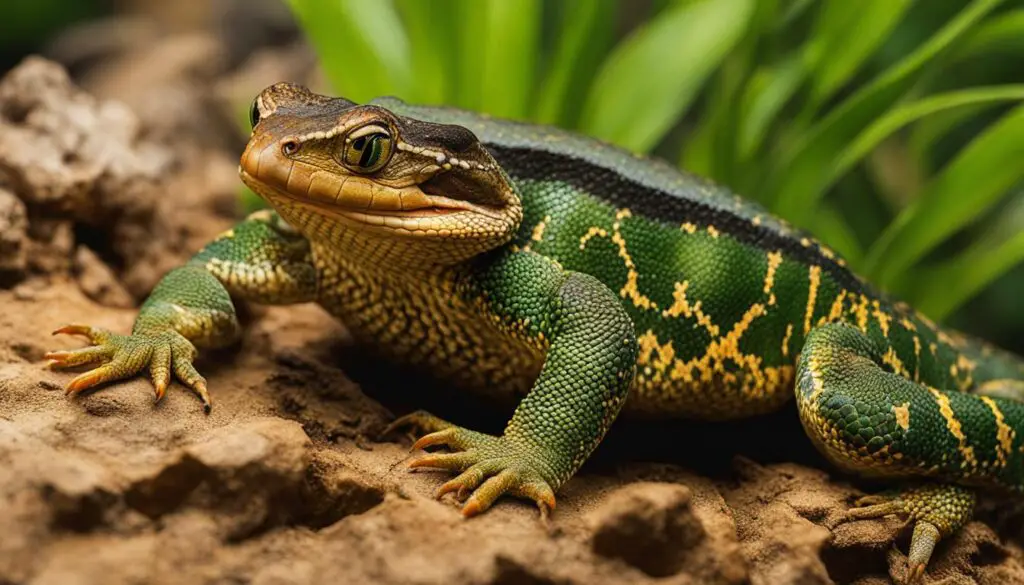Cyprus is a haven for wildlife enthusiasts, boasting a diverse array of native animals. From mammals and amphibians to reptiles, birds, and insects, the island offers a rich tapestry of animal diversity. The unique geography and climate of Cyprus provide various habitats for these creatures to thrive. However, preserving these natural habitats has become a pressing concern due to urbanization and human activities. Thankfully, conservation efforts are underway to protect the native animals and safeguard the animal diversity in Cyprus.

Key Takeaways:
- Cyprus is home to a diverse range of animal species, including mammals, reptiles, birds, amphibians, and insects.
- The island’s unique geography and climate offer a variety of habitats for these animals to thrive.
- Conservation efforts in Cyprus aim to protect native animals and preserve the island’s animal diversity.
- Urbanization and human activities pose a threat to the natural habitats of Cyprus.
- Preserving these habitats is crucial for the survival of unique species and maintaining biodiversity on the island.
Fauna of Cyprus
The fauna of Cyprus is characterized by a variety of animal species. While Cyprus has relatively few mammal species, it is home to endemic species found nowhere else in the world. These include the Cypriot mouflon, which is the largest wild animal in Cyprus, and the endangered Mediterranean monk seal. The island also boasts a rich bird population, including endemic species like the Cyprus warbler and Cyprus wheatear. The reptile and amphibian fauna of Cyprus is also diverse, with several endemic species and venomous snakes.
Cyprus, being an island in the Mediterranean, has a unique animal diversity. Although it has a limited number of mammal species compared to other regions, it compensates with the presence of endemic species that cannot be found anywhere else in the world. One of these unique animals is the Cypriot mouflon (Ovis orientalis ophion), which is the largest wild animal on the island. This species of wild sheep has long, curved horns and is highly adapted to the rugged terrain of Cyprus. The Cypriot mouflon is a symbol of the island’s natural heritage and plays a vital role in the ecosystem as a grazer.
The Mediterranean monk seal (Monachus monachus) is another notable endemic species in Cyprus and is considered one of the most endangered marine mammals in the world. These seals are known for their distinctive appearance with a sleek, dark brown or gray coat and large, expressive eyes. They can often be seen resting on secluded beaches or swimming in the crystal-clear waters surrounding the island.
In addition to mammals, Cyprus is also home to a diverse bird population. The island serves as an important stopover for migratory birds, as well as a breeding ground for endemic species. The Cyprus warbler (Sylvia melanothorax) and Cyprus wheatear (Oenanthe cypriaca) are two bird species that are unique to the island. These birds can be found in various habitats, from woodland areas to rocky landscapes. Their presence contributes to the overall biodiversity of Cyprus and adds to its allure as a birdwatching destination.
Reptile and Amphibian Fauna of Cyprus
Cyprus is home to a wide variety of reptile and amphibian species, including several endemic species. The island’s warm climate and diverse habitats provide ideal conditions for these cold-blooded creatures to thrive. Among the reptiles, there are venomous snakes such as the Cyprian blunt-nosed viper (Macrovipera lebetina lebetina) and the Cyprus whip snake (Coluber cypriensis). These snakes are an integral part of the ecosystem but require caution when encountered.
On the coastal areas of Cyprus, the endangered green turtle (Chelonia mydas) and loggerhead turtle (Caretta caretta) can be found nesting on the island’s beaches. These majestic sea turtles play a vital role in maintaining marine biodiversity and are protected by conservation efforts.
As for amphibians, Cyprus is home to three species of frogs: the marsh frog (Pelophylax ridibundus), the painted frog (Discoglossus pictus), and the green toad (Pseudepidalea viridis). These amphibians are highly adapted to the island’s wetland habitats and contribute to the ecological balance.
Endemic Animal Species in Cyprus
| Animal Species | Scientific Name | Conservation Status |
|---|---|---|
| Cypriot Mouflon | Ovis orientalis ophion | Near Threatened |
| Mediterranean Monk Seal | Monachus monachus | Critically Endangered |
| Cyprus Warbler | Sylvia melanothorax | Vulnerable |
| Cyprus Wheatear | Oenanthe cypriaca | Least Concern |
Mammals of Cyprus
Cyprus is currently home to 21 known mammal species. One of the most iconic mammals on the island is the Cypriot mouflon, a wild sheep species that is endemic to Cyprus. This majestic creature is cherished for its distinctive curved horns and its unique place in the island’s culture.
Another notable mammal found in Cyprus is the Mediterranean monk seal. However, this species is classified as endangered and faces numerous threats to its survival, including habitat loss and human disturbance. Efforts are being made to protect and conserve the remaining populations of this endangered mammal.
“The Cypriot mouflon is a true symbol of Cyprus, representing our wildlife and heritage. We must continue to conserve and protect this magnificent creature for future generations.”
– Dr. Andreas Demetriou, Wildlife Conservation Society Cyprus
Additionally, Cyprus is home to the Cypriot mouse, which is the last remaining endemic rodent species on the Mediterranean islands. This tiny creature is a testament to the unique biodiversity of Cyprus and the need for its preservation.
In ancient times, Cyprus was home to larger mammals such as elephants and hippopotamuses. However, due to hunting and the limited extent of the island, these species became extinct. Today, several mammal species have been introduced to Cyprus by humans and now thrive in the wild, such as rabbits and foxes.
Mammals of Cyprus Table
| Mammal Species | Status |
|---|---|
| Cypriot Mouflon | Endemic and protected |
| Mediterranean Monk Seal | Endangered |
| Cypriot Mouse | Endemic |
| Rabbits | Introduced |
| Foxes | Introduced |
Birds of Cyprus
Cyprus is a paradise for birdwatchers, offering a rich variety of avian species. With over 380 recorded bird species on the island, it is a haven for both migratory and endemic birds.
Migratory Birds
Cyprus’s strategic location between Europe, Africa, and Asia makes it an essential stopover for migratory birds. These birds use the island as a resting point during their long journeys, providing birdwatchers with excellent opportunities to observe them in their natural habitat.
Among the migratory bird species that pass through Cyprus are Eleonora’s falcon, flamingo, and imperial eagle. These magnificent birds attract enthusiasts from around the world who come to witness their impressive migrations.

Endemic Bird Species
Cyprus is also home to two species of endemic songbirds: the Cyprus warbler and the Cyprus wheatear. These birds breed exclusively on the island and migrate south for the winter.
The Cyprus warbler is a small songbird known for its distinctive call. It can be found in the island’s scrubland and forests, offering birdwatchers a rare opportunity to observe this unique endemic species.
The Cyprus wheatear, on the other hand, is a small passerine bird that inhabits open areas and agricultural fields. Its striking white and black plumage make it easily recognizable.
Endemic Bird Species of Cyprus
| Bird Species | Habitat | Conservation Status |
|---|---|---|
| Cyprus Warbler | Scrubland and forests | Near Threatened |
| Cyprus Wheatear | Open areas and agricultural fields | Least Concern |
These endemic bird species are a testament to Cyprus’s unique avifauna and the island’s importance for biodiversity conservation. Birdwatchers and nature enthusiasts can enjoy the beauty and diversity of these special birds, contributing to the appreciation and protection of the island’s natural heritage.
Reptiles and Amphibians of Cyprus
Cyprus is known for its diverse range of reptile and amphibian species, adding to the rich wildlife found on the island. With approximately 22 reptile species and 3 amphibian species, Cyprus offers a unique habitat for these fascinating creatures.
Among the reptiles, you can find a variety of snakes, lizards, and turtles. These reptiles contribute to the island’s vibrant ecosystem. However, it’s important to note that some reptile species in Cyprus, such as the Cyprian blunt-nosed viper, are venomous and pose a threat to humans and other animals.
One of the notable reptiles in Cyprus is the sea turtle. The island is home to two species of sea turtles – the green turtle and the loggerhead turtle. These magnificent creatures nest on the island’s beaches, making Cyprus a critical nesting site for their survival.
Alongside the reptiles, Cyprus also has three species of frogs, which are part of the island’s amphibian fauna. These amphibians contribute to the overall biodiversity and ecological balance in Cyprus.

The Importance of Reptiles and Amphibians
Reptiles and amphibians play crucial roles in ecosystems. They help control populations of insects and other small animals, which helps maintain a balanced ecosystem. Additionally, reptiles and amphibians serve as indicators of environmental health. Their presence or absence can often indicate the condition of their habitat and alert us to any potential environmental issues.
Conservation Efforts for Reptiles and Amphibians
Given the importance of reptile and amphibian species, conservation efforts are underway in Cyprus to protect and preserve their populations. These efforts focus on habitat conservation, educational initiatives, and raising awareness about the importance of these animals for Cyprus’ biodiversity.
“Reptiles and amphibians are essential components of Cyprus’ natural heritage. Preserving their habitats is crucial for maintaining the island’s unique ecological balance and protecting these fascinating creatures for future generations.” – Dr. Maria Smith, Herpetologist
Insects of Cyprus
Cyprus is known for its rich insect biodiversity, with approximately 6,000 species inhabiting the island. Among these fascinating creatures, butterflies take center stage, with a recorded total of 52 species in Cyprus. What makes these butterflies even more special is that nine of them are endemic to the island, meaning they cannot be found anywhere else in the world.
Insects play a vital role in the ecosystems of Cyprus. As pollinators, they facilitate the reproduction of plants, ensuring the continuity of various species. Additionally, insects serve as decomposers, breaking down organic matter and recycling nutrients back into the environment.
From an economic perspective, insects in Cyprus have both positive and negative impacts. They greatly benefit agriculture by pollinating crops and aiding in pest control. On the other hand, some insect species are known pests that can cause damage to crops and infrastructure.
Overall, the insect diversity in Cyprus is a testament to the island’s unique ecological landscape. These small creatures contribute to the overall balance and beauty of the natural environment.
Conservation Efforts in Cyprus
The diverse wildlife and natural habitats in Cyprus are under constant threat from urbanization, deforestation, and other human activities. In order to protect the native animals and preserve the biodiversity of the island, various organizations and conservation efforts are in place throughout Cyprus. One such organization is Terra Cypria, which is dedicated to conserving the Cypriot environment and its unique wildlife.
“Conservation is not just about saving individual animals or habitats, but also about preserving the delicate balance of nature and ensuring the long-term sustainability of ecosystems,” says Dr. Maria Papadopoulou, head of Terra Cypria’s conservation department.
Terra Cypria focuses on several key aspects of animal conservation in Cyprus, including habitat preservation, species protection, and raising awareness about the importance of wildlife conservation. By working closely with local communities, government agencies, and international partners, Terra Cypria aims to create a sustainable future for Cyprus’ natural heritage.
Habitat Preservation
Habitat destruction is a major threat to the survival of many animal species in Cyprus. Terra Cypria actively works to protect and restore critical habitats, such as forests, wetlands, and coastal areas. Through their efforts, they aim to create safe havens where animals can thrive and reproduce.
Species Protection
Endangered species in Cyprus, such as the Mediterranean monk seal and the Cyprian blunt-nosed viper, are given special attention by Terra Cypria. These species are closely monitored, and conservation measures are implemented to ensure their survival. In collaboration with scientific researchers and local experts, Terra Cypria conducts studies and conservation programs to protect and manage these vulnerable populations.
Awareness and Education
Raising awareness about the importance of animal conservation is a crucial part of Terra Cypria’s mission. They organize educational programs and outreach initiatives to engage with local schools, communities, and visitors. By promoting a deeper understanding and appreciation for Cyprus’ unique wildlife, they hope to inspire individuals to become stewards of nature and actively participate in conservation efforts.
Through the combined efforts of organizations like Terra Cypria and the support of dedicated individuals and communities, Cyprus continues to make progress in animal conservation and habitat preservation. However, the ongoing challenges of urban development and unsustainable practices necessitate continued commitment and action to safeguard the rich biodiversity of Cyprus for future generations.
Conclusion
The wildlife of Cyprus is incredibly diverse, with a range of endemic and migratory species inhabiting the island. Cyprus is a haven for animal lovers and nature enthusiasts, offering unique opportunities to observe and appreciate its rich animal diversity.
However, the natural habitats in Cyprus face significant threats from human activities, such as urbanization and deforestation. To ensure the survival of these unique species and maintain the ecological balance, it is crucial to prioritize the protection and preservation of these habitats.
Conservation efforts are already in place, with organizations like Terra Cypria working diligently to protect the native animals and their habitats. Through habitat preservation, species protection, and raising awareness about the importance of wildlife conservation, Cyprus can continue to be a sanctuary for its native animals for generations to come.
FAQ
What kind of animals can be found in Cyprus?
Cyprus is home to a diverse range of animal species, including mammals, amphibians, reptiles, birds, and insects.
Are there any endemic animal species in Cyprus?
Yes, Cyprus is home to several endemic animal species, including the Cypriot mouflon and the Cyprus warbler.
Which mammal species are found in Cyprus?
Cyprus is home to 21 known mammal species, including the Cypriot mouflon, Mediterranean monk seal, and Cypriot mouse.
What bird species can be found in Cyprus?
Over 380 bird species have been recorded in Cyprus, including migratory species like Eleonora’s falcon and endemic species like the Cyprus warbler.
What reptiles and amphibians are found in Cyprus?
Cyprus is home to about 22 reptile species, including venomous snakes, and 3 amphibian species, including frogs.
How many insect species are there in Cyprus?
It is estimated that there are around 6,000 insect species in Cyprus, including 52 species of butterflies, 9 of which are endemic.
What conservation efforts are in place in Cyprus?
Conservation efforts in Cyprus focus on habitat preservation, species protection, and raising awareness about the importance of wildlife conservation.
Why is it important to protect the wildlife in Cyprus?
Protecting the wildlife in Cyprus is important to preserve biodiversity and ensure the survival of unique species that are endemic to the island.
